by Winding Pathways | Dec 6, 2018 | Geology/Weather, Preparedness
- Note: Our comments are personal observations. We have not been paid by any company to review their products.
Wildfires in California. Hurricanes along the coast. Blizzards and tornadoes everywhere. In this era of climate change every household should prepare for long stretches without electrical power or even the possibility of evacuating at short notice. And the recent earthquake in Alaska reminds us of the importance of being prepared especially in cold months when food, water, and shelter are critical.
Fortunately, many families have assembled emergency kits that include a mix of essential items useful when the lights go out. For detail see the Winding Pathways article on important items to stock in the kit. Emergency kits can be quickly grabbed if evacuation is needed and the contents help make life more comfortable should there be no need to leave but the house has no electricity.
Two items often are forgotten but become critically important during a widespread emergency. Be sure to keep these on hand:
CASH:
When the power goes out credit and debit cards probably won’t work. Cash always works. Keeping a couple of hundred dollars in small bills makes buying necessary items during a power outage possible. It’s a good idea to hide money somewhere in the emergency preparedness kit.
CHARGING:
When Hurricane Sandy left millions of people without electrical power for weeks a critical problem was the inability to charge cell phones and other electronic devices. The cell network was operating since companies have backup generators. But most people’s phone batteries discharged, and they had no ready way to recharge them. Fortunately, there are several options for charging. Here are two that work well:
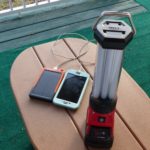
Solar chargers help keep people connected when the power goes out.
Solar chargers: Small inexpensive solar powered devices charge phones when placed in the sun. These are sold in camping and electronic stores. They will work on cloudy days, although charging will be slower than when the sun shines.
Battery chargers: For many years we’ve used Milwaukee brand drills and saws for projects around the house. The company recently sent us an ideal product to solve two problems posed by power failures. It is a light powered by the same lithium-ion batteries that run power tools. The light has a port enabling connection with cell phones. It charges them up quickly. We always keep four batteries fully charged, and each battery will run the light for many hours and recharge a phone several times. The light is surprisingly bright, and we’ll bring it on future camping trips instead of our old gasoline lantern. This device fills two emergency needs-light and charging.
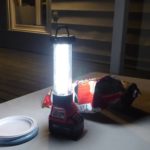
The lantern throws excellent light after dark.
When buying cordless power tools and other accessories it’s a good idea to purchase ones that can both run the tools and charge a phone.
Potable Water:
There is a third item that’s also often forgotten. That’s drinking water. We keep in storage 25 gallons of clean water in five-gallon containers. Should that run out we have two backpacker style filters that remove bacteria and viruses from water. If we need even more water, we keep a few tiny jars of water purification pills in our emergency bin. Water filters and purification tablets are sold in camping stores and are usually marketed to backpackers. These enable purifying water from nearby ponds and streams.
Hopefully, the power won’t ever go out, but the reality is that storms are increasing. Along with them comes higher odds that the power will go out. It’s best to be ready.
by Winding Pathways | Nov 22, 2018 | Garden/Yard, Geology/Weather, Nature
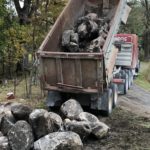
Glacial rocks arrive at Winding Pathways.
A modern glacier visited Winding Pathways in October.
Our area of Iowa doesn’t have much rock. There’s limestone bedrock in some places. Over the top is a thick layer of subsoil and topsoil with one exception. Glacial erratics.
Thousands of years ago the Upper Midwest was a cold world. Summers were so frigid that the previous winter’s snow didn’t melt. It packed down on top of previous winter’s snow and formed ice. Thick ice is fluid. It moves. Slowly. But it moves. Up in today’s Minnesota, glaciers scooped up granite and other rocks and gave each one a grand, if pokey, ride. As the ice inched forward, often southward, it carried rocks. Often they churned along the bottom of the ice, gradually rounding off like pebbles in the ocean surf do.
Fifteen or twenty thousand years ago the climate warmed. Ancient climate change. Instead of expanding, glaciers shrank, leaving their stone cargo in place, often hundreds of miles from where they were scooped from the ground.
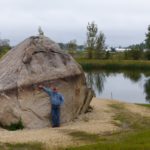
This massive erratic is the centerpiece of a new Marion, IA, park.
It’s complicated because there were several glacial periods of warming and cooling. Sometimes a new glacier picked up and moved rocks left by earlier ice sheets thousands of years earlier. The last glacier to visit Iowa melted about 12,000 years ago, leaving erratics here and there in the prairie that was converted to farm fields. Two of the most renowned glacial erratics in Eastern Iowa are Waldo’s Rock in Marion, and Bever Park’s boulder that generations of kids have climbed.
At Winding Pathways, we needed a retaining wall and first considered using manufactured concrete blocks. Then, we met Cody Rossman of Hardscapes. His business crafts glacial erratics into retaining walls. It’s not easy. Those hunks of rounded granite are heavy.
Cody’s crew brought truckloads of erratics to our yard from where the last glacier abandoned them near Troy Mills, Iowa. It took a husky truck about 45 minutes to bring the rocks 24 miles. That’s nearly 30 miles an hour.
It’s not certain how fast glaciers moved rocks, but it was slow. It could have taken years, decades, or even centuries for ice to move our rocks 24 miles. A speedy glacier might move a rock a mile a decade. Maybe a mile a century. Cody’s method was faster.
The wall’s in place. Every time we look at the rocks we wonder about their travel. Probably they originated in Minnesota hundreds of thousands of years ago to end up preventing erosion in our yard. What stories they could tell? Winding Pathways will find out in a few weeks when retired geologist, Ray Anderson visits and inspects the rocks and shares their stories.
Our wildlife also loves the rocks. A chpmunk popped up between two rocks as soon as the work crews left for the day. The uneven rock surfaces and the nooks and crannies between them provide safe living spaces for our chipmunks and garter snakes.
-
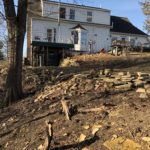
-
View of the old wall.
-
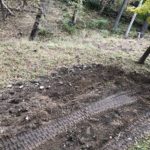
-
The old retaining wall material was removed first.
-
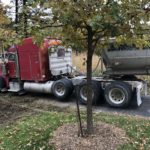
-
Glacial rocks arrive.
-
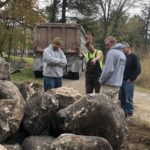
-
Sorting the rocks.
-
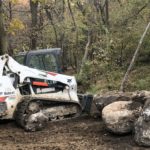
-
Bobcat moves rocks.
-
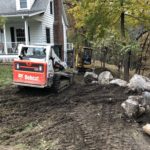
-
The rock wall takes shape.
-
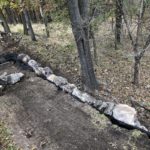
-
After excavating, geotextile is placed and glacial rocks arranged.
-

-
Hardscapes crew surveying the project.
-
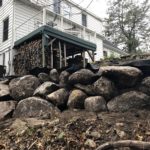
-
The rock wall is firmly in place.
-
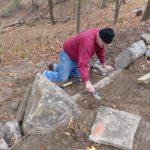
-
Limestone slabs are perfect for making steps.
-
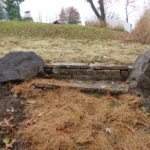
-
Milestone steps into the natural area.
-
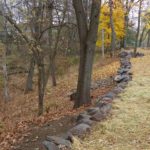
-
Straw protects grass seed and soil from eroding.
by Marion Patterson | Jun 21, 2018 | Geology/Weather, Nature, Reflections/Profiles, Wonderment
“Take Time. Make Time”
Guest Blogger
Connie Sjostrom
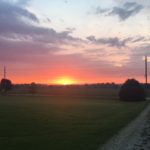
Sunrise comes early in Summer.
After working 40 years of my life, I was fortunate to be able to retire early. Always a multi-tasker while I was a working mom, you can imagine that much of my spare time was, well, not really spare. I vowed early on that my children should not miss out on “mom time” because I was working. That meant that some other things had to give a little. Like housework…that was easy
to cut. The only “extra time” I allowed myself before the family began to stir was a cup of coffee and a scan of the local paper WHILE I blow-dried my hair But getting back to my original point: when I retired, I knew it was going to take a bit to adjust to my new normal of no schedule. I developed two mantras –the first, “Slow Me Down, Lord”, and the second followed “Take time, make time.”
Like time to watch the sunrise.
Farm Life
Growing up on a farm I saw few sunrises mostly because I was already in the barn milking and there wasn’t a lot of extra time in those days. Milking 50 cattle morning and night…usually with only two people milking. You get the picture.
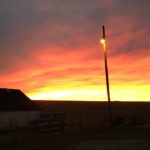
Arkansas Sunset
Photo by Connie Sjostrom
But, I saw lots of sunsets — mostly from a tractor. Back then we worked until it was dark, and sometimes later depending on the season. Still no camera handy. And if I did get a shot, I had to wait until the roll was full to get it developed. And usually, a few weeks for it to come back not to mention the trip to town to drop it off and pick it up. It was a real thing.
Commute
When we first married my husband and I enjoyed small town living but that involved a 45-minute commute to work and little extra time to catch the sunrise. Even when we moved to the country 27 years ago, I was still up early and getting ready for my day. We had the perfect spot — on top of a hill facing East-southeast. But until I retired I was hit and miss on taking the time to actually catch the sunrise. And then, I didn’t always have a camera at the ready, so very few were ever captured.
Fast forward to my retirement years. I now have hundreds (maybe thousands) of pictures of sunrises and I am so glad I can share those with others who may not have the time or the perfect location to view these masterpieces of creation. While Facebook has its drawbacks, being able to share a sunrise photo instantly is definitely a plus.
Sunrise this time of year is @ 5:30 a.m. Take time, make time!
-
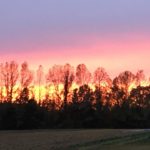
-
Along tree line.
Photo by Connie Sjostrom
-
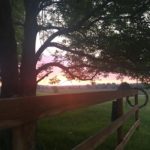
-
Sunrise along fence.
Photo by Connie Sjostrom
-
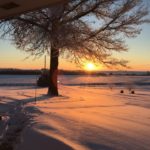
-
Sun shinning on snow.
Photo by Connie Sjostrom
-

-
Blue tints as sun rises.
Photo by Connie Sjostrom
by Winding Pathways | Apr 12, 2018 | (Sub)Urban Homesteading, Chickens, Foraging, Garden/Yard, Geology/Weather
You know Steve Brown is from Texas right away. Vernon, Texas, to be exact. Home of the Red River Valley Museum, that features native sons trombonist and singer, Jack Teagarden and singer-songwriter, Roy Orbison. Brown’s drawl and easy manner draw you in. But, there is something else in his voice – maybe a hint of an Eastern clip? Perhaps a touch of wry Midwestern humor? And, what about the creative way he describes raises chickens in the north?
Technology and Tinkering
All of these are part of Dr. Stephen Brown who has lived, studied and worked in Upstate New York, Kansas, and now Alaska. “I grew up raising chickens since age eight,” he stated. “I love the soap opera of the coop,” he added. An engineer and self-professed “tinkerer” Brown is smart, innovative and ambitious. Above all, he is good with people. Pretty important qualities since he is District Agriculture and Natural Resources Cooperative Extension Service Agent for the Mat-Su/Copper River District of Alaska. He integrates his specialties of Global Positioning System (GPS) and Geographic Information Systems (GIS) with agriculture and the environment.
He applies his advanced degrees in Environmental Sciences from the University of Texas at San Antonio and the State University of New York, and his numerous publications and presentations practically for those living in the far north.
As Alaskans learn to raise poultry, till the soil, and ward off predators Brown is right with them. “I get to remote homesteads by boat, airplane and snow machine,” he said. “I may be the only extension agent in the country with reimbursement mileage for a snow machine,” he quipped.
Adapting the Coop
“Chickens can adapt to the cold when they have a safe coop,” explained Brown. After arriving in Alaska about a dozen years ago, he experienced some of the challenges of “high latitude farming.” He researched and presented keynote talks across the US and Canada. Then, he adapted methods that fit with homesteader lifestyles and pocketbooks. “You have to be practical because of the costs,” he explained. For example, temperature extremes make watering farm animals a problem. Since you don’t want to haul fresh water out every day and everything in Alaska is expensive, Brown adapted dog water bowls to stay heated in the winter for the low cost of about 15 bucks.
Brown also addressed other barriers to raising poultry in the far north. “Frostbite and ammonia build up are the two largest killers up here,” he explained. To prevent frostbite on chickens’ toes, Brown simply installed flat perches instead of round ones, so the chickens’ feathers covered their toes when they roost. Frostbite solved.
Animals also need to be safe from predators – bears and mosquitoes. So, the coop must be sturdy, have mosquito netting inside heavily wired windows, and have good ventilation. He converted an old horse stall to a secure, ventilated and warm chicken coop. He affirmed that chickens can handle the cold and only adds a heat lamp when temperatures really drop into the double-digit minus degrees.
Tom Sawyer Method
The deep litter method works well to keep the coop fresh and prevent ammonia build up. Spread a thin layer of fresh litter about once a week and toss in some treats for the chickens to scratch and keep the litter turned over. A couple of times a year he uses the “Tom Sawyer” method of cleaning up the coop. “I invite local gardeners to come over to my place twice a year and clean out the deep litter. I show them how to use it in their gardens to improve their soil for better crops,” he explained. Win-win.
Some poultry techniques he teaches in “Chicken U” classes which fill up. These include such basics as how to safely catch, hold, and butcher a chicken. Classes are booming and so is poultry husbandry. According to Brown, in the past eight years, chicken orders have skyrocketed from single thousands to well over 120,000. He gets to experience the great results of good husbandry and farming in part because he is president of the Alaska State Fair board of directors. The State Fair runs late August.
Marathon Man and Mountaineer
In his position, Brown is passionate about more than chickens. He has been on the cutting edge of promoting Rhodiola rosea as an important cash crop for Alaskans.
And, he is not all work and no play. His recreational pursuits run deeply, too – literally. He’s a marathoner and mountaineer. Since 1979 Brown has summited numerous peaks and seeks to summit on all continents. He even mused about taking a chicken to the top of Denali. “Even though I am no a spring chicken myself, I think it’d be kinda fun,” he said.
Call him up some time to chat chickens and crops. You’ll know him at the Alaska State Fair by his drawl and friendly manner that draws you in.
by Winding Pathways | Mar 17, 2018 | Garden/Yard, Geology/Weather, Mammals, Nature, Wonderment
Don’t Miss March’s Launch of Spring
“If we do not permit the earth to produce beauty and joy
it will in the end not produce food either,” Joseph Wood Krutch.
Too many people miss March’s majesty by staying indoors. After all it’s usually too warm to enjoy cross country skiing or ice fishing and it’s too early to plant the garden, go fishing, or play golf. March is the month of mud, fog, slowly melting grit-encrusted snowbanks, and clammy cold.
At Winding Pathways, we defy normal behavior and spend March days outdoors. It’s the month of great change and nature’s cavalcade is there for any observant person to enjoy.
Just consider the earth and how it’s turning toward our sun. Days lengthen the most around the March 21st Vernal Equinox. This means there is more sunlight each day allowing our yard to soak up more solar energy and spark spring’s revival of life.
March is the month to pull on mud boots and venture outdoors with eyes and ears attuned to the great seasonal change upon us. Here are some things to absorb with great joy:
-

-
“Possum come aknockin’ at the door.”
-

-
Look Up and see skeins of geese winging across the sky
-
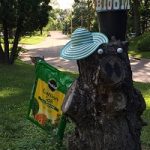
-
Gardening
Birds.
Migration has started. Look up! Way up. Skeins of geese wing high overhead, perhaps so high they are mere specs. Binoculars bring them closer. And their distant and distinct song is music to winter weary ears. Salute their northward journey with a hearty, “Welcome Back!” Many smaller birds are on the prowl, but it may take a close look to notice them. Within a month juncos disappear shortly after red winged blackbirds make their annual debut. Sparrows begin crafting messy nests as goldfinches swap their drab winter outfits for glorious yellow garb. Barred owls fill the night air with haunting cries of WHO COOKS FOR YOU FOR YOU. Sometimes they are in a black oak almost over our roof and startle us awake with their lusty calls.
Mammals.
Even as winter’s song hangs on, baby squirrels are nestling in tree cavities and rapidly growing on a diet of mom’s rich milk. Squirrels are among nature’s most attentive mothers. In another month or two they encourage their babies to venture outdoors. Cottontails begin mating, buck deer begin growing new antlers, chipmunks are increasingly active, and raccoons and opossums prowl the nocturnal yard seeking dinner. On warm misty nights they gorge on nightcrawlers that have emerged on the lawn’s surface to mate.
Plants.
We’re always delighted to find stinging nettles springing out of the still cold earth toward the end of March. There’s no better tasting or nutritious cooked green than a short pile of steaming bright green nettles on the dinner plate. It’s the best time of the year to enjoy tender dandelions leaves in salad. We like the non-bitter blanched leaves discovered under a carpet of oaks. By summer, these leaves are too tough and bitter to enjoy. But, now, they are delicious and nutritious. We can pluck them because we have a spray-free yard.
Spring’s miracle sound.
Sometimes this miraculous sound happens in March but always by early April. Nature’s most promising song comes at vespers each spring, usually in the calendar interval where Easter can fall – March into April. Spring peepers and chorus frogs herald the season each evening. As Christians worldwide celebrate Easter by saying HE IS RISEN, Chorus frogs and peepers enthusiastically seem to announce SPRING IS COMING!
Go Outside! Don’t miss the great vernal seasonal turn. March isn’t a month to huddle by the television. It’s a month to be outside.
-
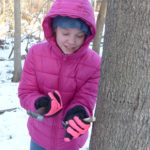
-
Girls taps a Maple Tree
-
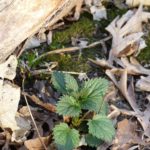
-
Nettles are one of the first greens to poke up through the ground.
-
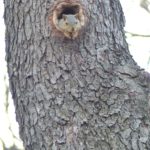
-
Young Squirrel in tree.
-
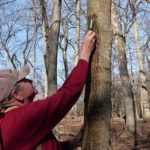
-
Sapsucker holes in tree.
-
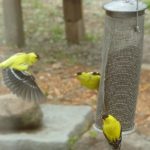
-
Male Goldfinches begin to color up.
-
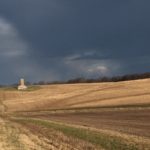
-
Dark clouds over farmland.
by Winding Pathways | Feb 8, 2018 | Geology/Weather, Nature
Ice is a miraculous substance. Actually, it is water that is so amazing. Ice is just one of its three phases.
Water is essential for life and one of its unusual characteristics is how it behaves when its temperature drops. Like most substances water contracts as it gets colder, but unlike other substances, it reaches maximum density at 39 degrees Fahrenheit and then expands as it gets colder. Finally, when it freezes at 32 degrees Fahrenheit it expands.
That’s huge! If Ice were denser than water, it would sink to the bottom of a lake or pond. The surface would continue to freeze and sink until by mid-winter the lake would be all ice. Few creatures could live there.
Instead, when water freezes it expands and gets lighter. It floats on the colder water beneath and insulates the water, so it doesn’t freeze all the way to the bottom. Ice is merely a veneer floating on water, enabling life in the liquid below it.
It might be 20 below zero in the air above the ice but down in the water a fish basks in the relative warmth of water in the 30s.
When lake ice gradually cools as fall’s temperature drops a beautiful result happens in some years. On one cold, clear, calm night the lake will form a layer of crystal clear ice several inches thick. It’s hard and usually safe to walk on.
The walk reveals amazing patterns of cracks and fractures. Clear ice gives a lake walker the sensation of striding on air with a clear view to the bottom beneath the feet. For an idea of the beauty of ice, enjoy these photos taken at Cedar Lake, Denville, New Jersey, in January 2018.
-
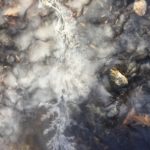
-
Bald Hill Ice
-
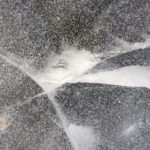
-
Ice Fractures
-
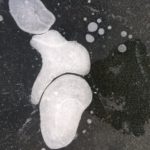
-
Fascinating patterns in the ice.
-
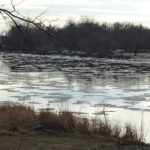
-
Ice expands as its temperature drops, so it floats!
-
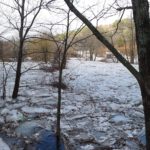
-
Photo by Bob Fehsinger
-
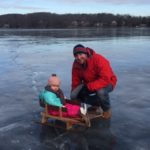
-
Learn to enjoy lake ice safely.





































